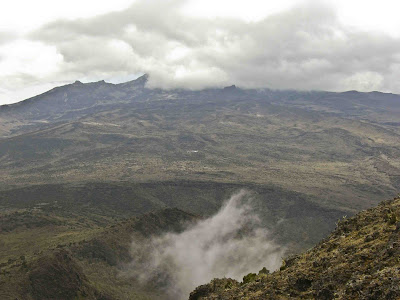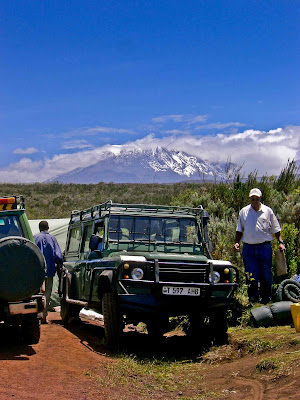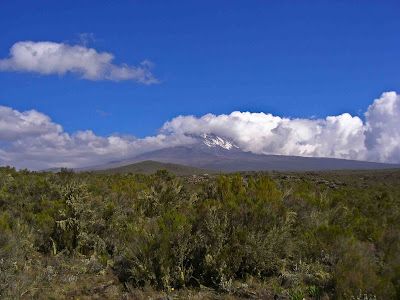Ascent : 500 m
Descent : 150 m
We awoke again to the call of "Washy washy!" from one of the porters who brought us our warm water to wash with and the sweet tea to coax us out of bed - both were welcome and did their jobs exceptionally well although the dust that had been ground into our clothing from the first two days was definately there to stay.
We all had breakfast and it was clear at this point that some of the group had not slept well, if at all.
We set off on our trek up to the Moir Hut Camp, here the terrain became even more barren and moon- like, we were now leaving the moorland climatic zone and heading into the alpine desert. This wasn't really much of a walk and only took around 3 hours. Whilst not suffering from the altitude at this point my groin was feeling the effect of not wearing suitable underwear and was feeling a bit chaffed. I did preempt this however and was carrying talk for this eventuality (or possible foot problems) hiding behind a rock I made sure and dumped a load down the back of my undercrackers, the rest of the tub was whisked skywards in the wind, I was met with some funny looks from the rest of the party who understood when I explained what I'd been doing. We walked past some quite obvious lava flows which reminded us all that we were in fact hiking up a volcano.
We arrived at the Moir Hut campsite, so called due to Moir Hut, the remains of which are still there. This was built to house hikers attempting to summit Kilimanjaro some 20 years ago however there is not a great deal left of it now and has basically been left to the elements with a lot of the cladding and insulation now missing. It was at this time that we checked the temperature as one of the guys had a thermometer on their pack and for the first time the temperature had dropped below freezing.
One of our team was sick as we arrived at the camp at 4200 metres although I was still feeling pretty ok. At this height doing anything from walking to even taking your pack off was laboured and it took a few moments to get your breath back. The campsite itself was quite sheltered with a large rock wall running along one side of the camp which eradicated the wind from ripping through us. We were told to have a rest before lunch as we were to head off into the Lent Hills above the camp for an acclimatisation walk which we did but not before heading to the loo. The facilities on Kilimanjaro, as I'm sure you can imagine, are pretty primitive and are a touch limited. The toilets are nothing more than longdrops which are less than fragrant at the best of times. The one and only toilet here however was slightly less offensive then the others, in part due to the fact that it had no door and you were exposed to the elements, the view was pretty impressive mind, just a shame there was no seat to allow you to relax whilst taking in the view.
We ate lunch and had a bit of a lie down before we headed off on our acclimitisation walk to an altitude of 4700m in the Lent hills, one of the guys stayed behind in order to try to catch up on some much needed sleep that he'd missed for the last two nights due to the queeziness he'd been experiencing.
The walk took us over a huge lava flow, there was pretty much no life now as this altitude. We could see the point we were heading to which was around 500 metres above the camp. We zig-zagged up to the ridge and had to walk round to the back side of the pinnacle where we then had to climb to the summit of Lent Hills. The views from here were awesome and we had a great view down to our campsite where the tents were like specks in the distance from up here.
For some reason those visitors that had been there before us had balanced rocks in strange formations and shapes which we duly added to and took photos - the mind does strange things up here. On the descent the cloud followed us down to the camp bringing the temperature down with it.
Robert the chef prepared us a feast of Soup, Spag Bol and banana fritters which went down so well. Shortly afterwards at around 8pm we headed to bed leaving some of the other guys up playing cards.





























